The Samsung 950 Pro PCIe SSD Review (256GB and 512GB)
by Billy Tallis on October 22, 2015 10:55 AM ESTMixed Random Read/Write Performance
Most real-world use consists of a mix of reads and writes, and interleaving the two often poses a particular challenge to drive controllers. This mixed random access test is conducted across a 16GB span of the drive, but on a full drive and with a queue depth of 3.
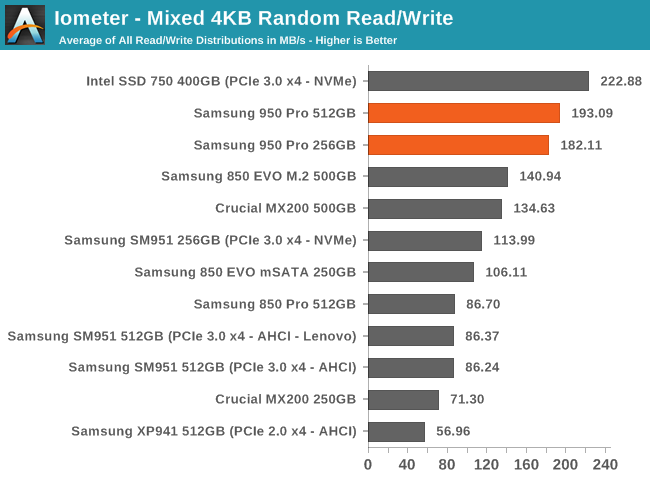
Mixed random access seems much improved over Samsung's earlier M.2 drives, and the 950 Pros fall behind only the Intel SSD 750. The 512GB drive is well behaved here and surpassing the 256GB drive as it should.
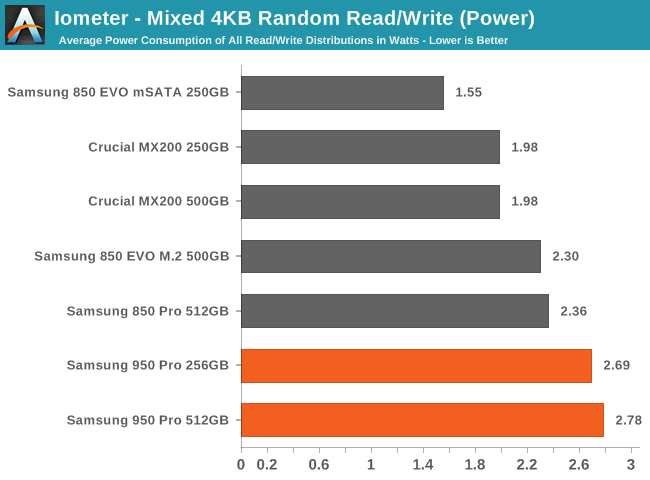
In this case, the higher power consumption of the 950 Pro is very well justified by the higher performance.
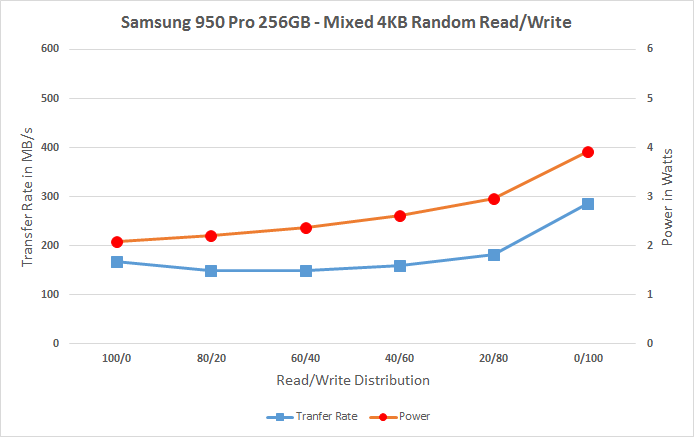 |
|||||||||
There's not much variation across the different workloads. Performance hardly drops during the middle of the test where many controllers have trouble with a balanced mix, but on the other hand the performance at either end of the test is nothing spectacular. Power consumption climbs hand in hand with the proportion of writes, but is accompanied by some increasing in overall data rate.
Mixed Sequential Read/Write Performance
The queue depth of 3 is sufficient for many drives to perform very well at either end of this test, while testing 100% reads or 100% writes. In between, performance typically suffers greatly, and that's where the winners and losers of this test are determined. Anything that's duplicating duplicating or transforming a large amount of data on the drive will produce I/O patterns similar to this test. Creating a System Restore snapshot, backing up files to a different directory on the same drive, and file compression can all produce interleaved reads and writes of large blocks of data, though not necessarily fast enough to be limited by the drive's performance.
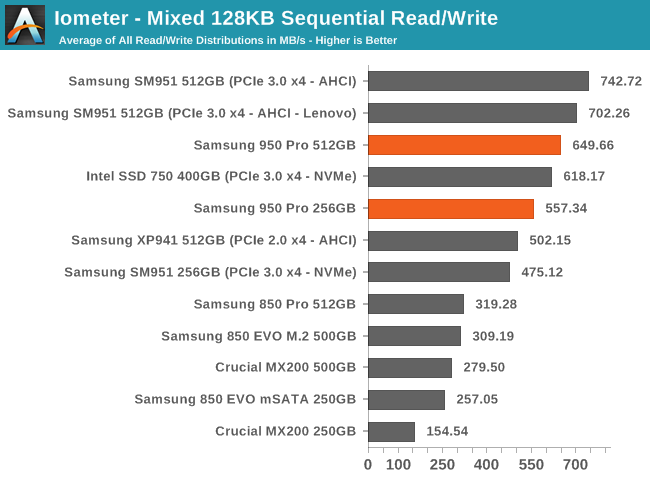
These sequential workloads allow the PCIe drives to stand out and achieve average speeds that would saturate SATA.
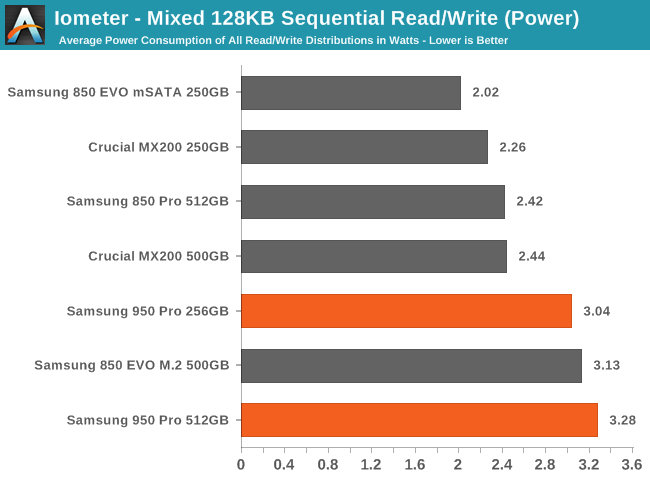
With power consumption in the same neighborhood as the SATA drives, the 950 Pro is significantly more efficient.
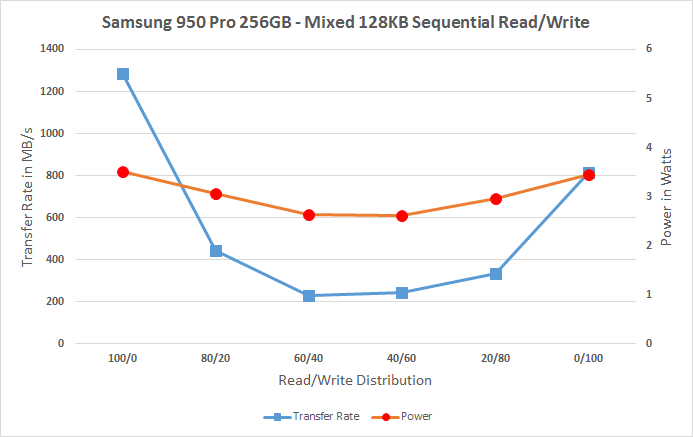 |
|||||||||
Looking at the breakdown by workload, the 950 Pro performs well on the balanced mixes and far outstrips the SATA limit on the very read-heavy workloads and the pure write section at the end of this test.










142 Comments
View All Comments
AnnonymousCoward - Thursday, October 22, 2015 - link
This 5,600-word review utterly fails to penetrate to the bottom-line answer: the 950 Pro gives virtually zero desktop-usage performance advantage, while costing more than double of SATAIII drives. That only took 17 words.http://techreport.com/review/29221/samsung-950-pro...
Redstorm - Thursday, October 22, 2015 - link
Quote: "Lucky for that Samsung 950 Pro SSD or i would never have made that head shot" - said no one ever.PVG - Thursday, October 22, 2015 - link
I don't want to believe you tested a PCIe 3.0 4x drive on a board with a PCIe 2.0 x2 M.2 socket, so I'm guessing you used some kind of PCIe card adapter hooked up to the 3.0 lanes from de CPU, right?Billy Tallis - Friday, October 23, 2015 - link
Yep. We're always using the PCIe lanes off the CPU, and with a riser card and adapter that allows for the power measurement.PVG - Saturday, October 24, 2015 - link
That sounds like a cool setup. You should show it, sometime. ;)zodiacfml - Friday, October 23, 2015 - link
I'm just impressed with the SM951. All these PCIe drives are not terrible and gives excellent performance over SATA anyway. Their differences are pretty negligible in real world use. The challenge now (esp. for Samsung) is more capacity and lower prices.I can't shake the idea of NAS devices with M.2 drives.
zodiacfml - Friday, October 23, 2015 - link
Additionally, NVMe doesn't improve much for the clients. It seems like a specification they added on consumer drives to increase its adoption to benefit their server/enterprise storage products.wyewye - Friday, October 23, 2015 - link
Billy, you shit the bed: half of graphs are randomly missing Intel 750, the only competing consumer drive.However, good job on highlighting the termal issues of 950 Pro.
lilmoe - Saturday, October 24, 2015 - link
Welcome to the world of amazingly consistent charts, brought to you by Anandtech.SyukriLajin - Friday, October 23, 2015 - link
who knew that storage would require bandwidth as high as a graphic card. just a few years ago, it's the slowest component of your computer.